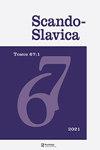Special Issue: Russian Historical Morphosyntax in the Light of Language Contact
IF 0.2
0 HUMANITIES, MULTIDISCIPLINARY
引用次数: 0
Abstract
This issue of Scando-Slavica is devoted to the topic of morphosyntactic change in Russian in the light of language contact. It is the outcome of two linguistics panels at the 21 Conference of Scandinavian Slavists that took place in August 2019 at the University of Eastern Finland, Joensuu campus. The papers examine various aspects and possible morphosyntactic consequences of convergence during the development of the Russian language pointing to historical or prehistoric language contacts in the area of Northern East Slavic. While some papers deal with the phenomena that make Russian stand out against the background of even its closest relatives and may thus have been triggered by such contacts, others address broader issues and consider theoretical implications of contact phenomena, the specific contact configurations, and the interplay between internal and external factors in morphosyntactic processes. Andersen’s article addresses the origin and development of definiteness marking in the adjective phrase in Germanic, Baltic and Slavic, and considers three possible hypotheses of prehistoric bilingual language contact in various configurations, as well as areal convergence. The examination of the definite paradigms in all three language families at the earliest historical stages leads Andersen to the conclusion that they are archaisms rather than innovations. In the final analysis, Andersen prefers the idea of direct borrowing of definiteness marking from Germanic. He explains that contacts between Germanic, Baltic and Slavic went on for a very long time, occurring before the invasion of the Huns in 375 A.D. The Slavic and Baltic subordinators (the term he uses for the PIE pronoun *-yo attested in Indo-Iranian) changed into definite markers because of the contacts with East Germanic groups before then, and their spread continued thereafter. One part of Andersen’s article deals with the terminology and methodological issues of language contact. He elaborates on the idea of functional equivalence in language contact and stresses the importance of accounting for innovations on the level of the speaker in order to produce a realistic explanation of the process. Penkova investigates the problem of the periphrastic future formation with inchoative auxiliaries during the Middle Russian period. Leaning on特刊:从语言接触看俄罗斯历史形态句法
这一期的《语言语言学》致力于从语言接触的角度研究俄语的形态句法变化。这是2019年8月在东芬兰大学约恩苏校区举行的第21届斯堪的纳维亚斯拉夫主义者会议上两个语言学小组的成果。这些论文研究了俄语发展过程中趋同的各个方面和可能的形态句法后果,指出了东北斯拉夫地区历史上或史前的语言接触。虽然一些论文处理的现象使俄语在其最接近的亲戚的背景下脱颖而出,因此可能是由这种接触引发的,但其他论文则涉及更广泛的问题,并考虑接触现象的理论含义,具体的接触配置,以及形态句法过程中内部和外部因素之间的相互作用。安徒生的文章论述了日耳曼语、波罗的海语和斯拉夫语形容词短语中确定性标记的起源和发展,并考虑了史前双语语言在不同形态下接触的三种可能假设,以及区域趋同。安徒生对这三个语系在最早的历史阶段的明确范式进行了考察,得出了它们是古语而不是创新的结论。归根到底,安徒生更倾向于直接借用日耳曼语的明确标记。他解释说,日耳曼语、波罗的海语和斯拉夫语之间的联系持续了很长一段时间,发生在公元375年匈奴入侵之前。斯拉夫语和波罗的语的从属关系(他用这个词来指代PIE的代词*-yo,在印度-伊朗语中得到证实)由于在此之前与东日耳曼群体的接触而变成了明确的标志,此后它们继续传播。安徒生文章的一部分论述了语言接触的术语和方法论问题。他详细阐述了语言接触中的功能对等概念,并强调了在说话者层面上考虑创新的重要性,以便对这一过程做出现实的解释。Penkova研究了中俄时期带有创新助词的周边未来形成问题。靠在
本文章由计算机程序翻译,如有差异,请以英文原文为准。
求助全文
约1分钟内获得全文
求助全文

 求助内容:
求助内容: 应助结果提醒方式:
应助结果提醒方式:


